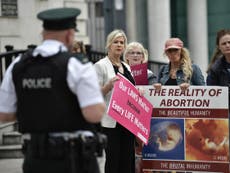The Home Office doesn’t think ‘passive’ protests outside abortion clinics are a problem – here’s why they’re wrong
I can’t begin to imagine how much more traumatic my experience would’ve been had someone questioned my decision

I remember shaking. Not enough to stop me from walking, but enough to make me feel faint. Then I started to get really hot. And that’s when I stopped breathing.
Six days earlier, I’d found out I was pregnant. I’d slept with someone who had taken the condom off and didn’t tell me until it was too late. He glibly suggested I get the morning after pill, which I did, only it didn’t work. At 23, having a child wasn’t even a speck on my radar. Let alone with someone who, in the short time we’d dated, had been so infuriatingly indifferent towards me that I felt silly for making a fuss about anything, including contraception. So I didn’t. Five weeks later, I found out I was pregnant and booked an appointment to have an abortion.
From the moment I arrived at the clinic to collect my first pill, when I had a panic attack outside, to the devastating sight of my body terminating a pregnancy and the inexplicable agony that followed, the experience was physically and psychologically traumatising. Two years later, I start to hyperventilate whenever I think about it.
But here’s the thing: I was so lucky. Not least because I wasn’t seeking a termination in horrific circumstances, such as rape, incest or domestic violence, but because my path to the clinic was quiet and clear, not figuratively, but literally. There were no anti-abortion protestors. Nobody tried to talk me out of my decision or follow me home. No one called me a “murderer”, told me I would go to hell, or offered to buy my baby. These stories might sound like something out of a Margaret Atwood novel, but they are the very real experiences of British women in the 21st century, whose calls for help have been ignored by the government.
In 2017, Amber Rudd called for a review into protests outside abortion clinics in England and Wales to see if it was necessary to introduce buffer zones. That way, protestors would be forced to stand at least 100 metres away, and no more than four could be present at any one time. Since then, two London-based clinics have seen significant benefits from implementing buffer zones independently with the help of their local councils. But it doesn’t look like others will follow suit any time soon.
More than 2,500 testimonies were submitted to the Home Office for the review, with many illustrating the shocking harassment women have been subjected to outside abortion clinics, including being filmed, shouted at, physically assaulted and being told that abortion is linked to breast cancer. In 2018, the government announced it would not be enforcing buffer zones because the review found that damaging protests were “not the norm” and “the majority of activities were more passive in nature”.
But documents obtained via freedom of information requests last month suggest the consultation was “flawed” and based on misrepresented evidence. It’s still not clear what happened, but clinic staff say none of their stories were included in the government’s evidence pack, nor were the submissions from medical bodies.
One civil servant working on the consultation was recorded as saying: “there is [a] need to be seen to do something but [we] don’t actually want to do something”. More than 30 organisations have since written to Priti Patel urging for another review. Patel has yet to respond.
The thing is, even if the protesting activities were “passive”, they would be no less insidious – maybe even more so. I have never felt more vulnerable than on the two days I went to the clinic to take the first and then second of the pills to induce a medical abortion. I’d been fairly blasé about the whole thing beforehand, convincing myself this was just another thing on my to-do list that I could tick off and then pretend had never happened. But when I got to the clinic that first day, my shield of cognitive dissonance had eroded. The abortion broke me, and it took months to piece myself back together.
I can’t begin to imagine how much more traumatic my experience would’ve been had someone questioned my decision. It wouldn’t have mattered whether it had been a group of protesters calling me “baby killer” or just one elderly man handing me rosary beads, it’s exploitation and it’s appalling. There is no such thing as a “passive” anti-abortion protester because trying to manipulate women on one of the most difficult days of their lives is unacceptable, no matter the scale.
Of course, critics will argue that buffer zones are an infringement on free speech. But trying to prevent women from accessing legal healthcare is not free speech, it’s a flagrant violation of human rights. If our female home secretary fails to recognise that, shame on her.



Join our commenting forum
Join thought-provoking conversations, follow other Independent readers and see their replies